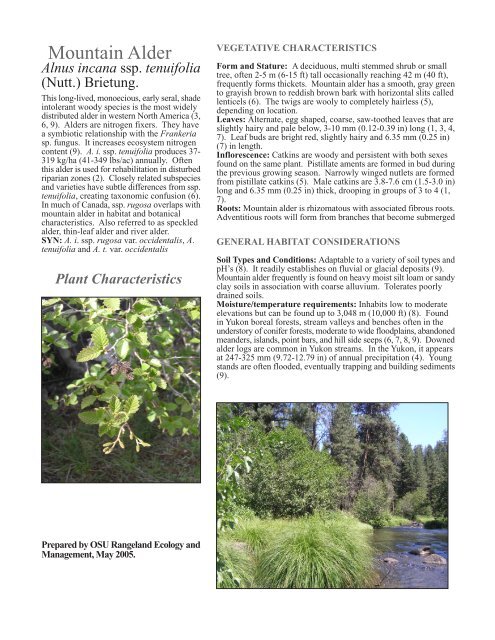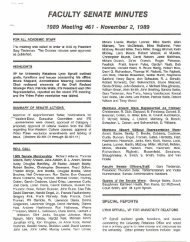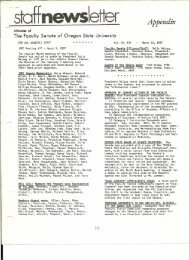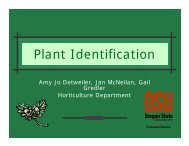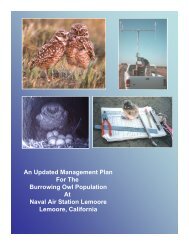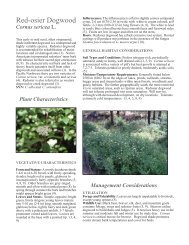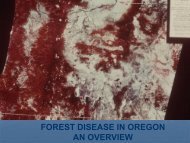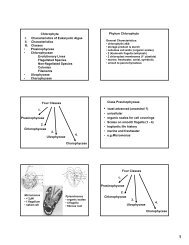Mountain Alder - Oregon State University
Mountain Alder - Oregon State University
Mountain Alder - Oregon State University
Create successful ePaper yourself
Turn your PDF publications into a flip-book with our unique Google optimized e-Paper software.
<strong>Mountain</strong> <strong>Alder</strong><br />
Alnus incana ssp. tenuifolia<br />
(Nutt.) Brietung.<br />
This long-lived, monoecious, early seral, shade<br />
intolerant woody species is the most widely<br />
distributed alder in western North America (3,<br />
6, 9). <strong>Alder</strong>s are nitrogen fixers. They have<br />
a symbiotic relationship with the Frankeria<br />
sp. fungus. It increases ecosystem nitrogen<br />
content (9). A. i. ssp. tenuifolia produces 37-<br />
319 kg/ha (41-349 lbs/ac) annually. Often<br />
this alder is used for rehabilitation in disturbed<br />
riparian zones (2). Closely related subspecies<br />
and varieties have subtle differences from ssp.<br />
tenuifolia, creating taxonomic confusion (6).<br />
In much of Canada, ssp. rugosa overlaps with<br />
mountain alder in habitat and botanical<br />
characteristics. Also referred to as speckled<br />
alder, thin-leaf alder and river alder.<br />
SYN: A. i. ssp. rugosa var. occidentalis, A.<br />
tenuifolia and A. t. var. occidentalis<br />
Plant Characteristics<br />
Prepared by OSU Rangeland Ecology and<br />
Management, May 2005.<br />
VEGETATIVE CHARACTERISTICS<br />
Form and Stature: A deciduous, multi stemmed shrub or small<br />
tree, often 2-5 m (6-15 ft) tall occasionally reaching 42 m (40 ft),<br />
frequently forms thickets. <strong>Mountain</strong> alder has a smooth, gray green<br />
to grayish brown to reddish brown bark with horizontal slits called<br />
lenticels (6). The twigs are wooly to completely hairless (5),<br />
depending on location.<br />
Leaves: Alternate, egg shaped, coarse, saw-toothed leaves that are<br />
slightly hairy and pale below, 3-10 mm (0.12-0.39 in) long (1, 3, 4,<br />
7). Leaf buds are bright red, slightly hairy and 6.35 mm (0.25 in)<br />
(7) in length.<br />
Inflorescence: Catkins are woody and persistent with both sexes<br />
found on the same plant. Pistillate aments are formed in bud during<br />
the previous growing season. Narrowly winged nutlets are formed<br />
from pistillate catkins (5). Male catkins are 3.8-7.6 cm (1.5-3.0 in)<br />
long and 6.35 mm (0.25 in) thick, drooping in groups of 3 to 4 (1,<br />
7).<br />
Roots: <strong>Mountain</strong> alder is rhizomatous with associated fibrous roots.<br />
Adventitious roots will form from branches that become submerged<br />
GENERAL HABITAT CONSIDERATIONS<br />
Soil Types and Conditions: Adaptable to a variety of soil types and<br />
pH’s (8). It readily establishes on fluvial or glacial deposits (9).<br />
<strong>Mountain</strong> alder frequently is found on heavy moist silt loam or sandy<br />
clay soils in association with coarse alluvium. Tolerates poorly<br />
drained soils.<br />
Moisture/temperature requirements: Inhabits low to moderate<br />
elevations but can be found up to 3,048 m (10,000 ft) (8). Found<br />
in Yukon boreal forests, stream valleys and benches often in the<br />
understory of conifer forests, moderate to wide floodplains, abandoned<br />
meanders, islands, point bars, and hill side seeps (6, 7, 8, 9). Downed<br />
alder logs are common in Yukon streams. In the Yukon, it appears<br />
at 247-325 mm (9.72-12.79 in) of annual precipitation (4). Young<br />
stands are often flooded, eventually trapping and building sediments<br />
(9).
Management Considerations<br />
UTILIZATION<br />
Forage and Palatability: Seldom to moderately consumed by<br />
cattle, sheep and goats. Stand accessibility determines amount of<br />
use (6). Cattle probably utilize this species more than sheep and<br />
horses. Often grazed if more palatable species disappear (6, 7).<br />
In the Blue <strong>Mountain</strong>s of <strong>Oregon</strong>, moderate cattle grazing was<br />
observed (7). This species is often found in grazing induced<br />
communities (9).<br />
Wildlife Use: Varied consumption from light to moderate depends<br />
on location. Young plants, leaves and twigs are eaten by moose,<br />
deer, and elk. Beavers build dams and lodges with sections of<br />
alders. Flowering buds, seeds, leaf buds, and catkins are consumed<br />
by birds. Winter browsing is common. Provides thermal and hiding<br />
cover for big game and birds. (6)<br />
PLANTING<br />
Growth Season and Seedling Establishment: Flowers in March<br />
to April, cones ripen in fall and disperse seeds thereafter. Catkins<br />
expand before the leaves, sometimes in the late winter months.<br />
In the Yukon, it experiences a short growing season (4). Leaves<br />
shed in autumn wile still green (8). European breeds of Alnus<br />
incana are faster growing and taller than their North American<br />
constituents (2).<br />
Propagation: Produces from rhizomes and seeds with low viability.<br />
Thickets are formed from rhizomes or suckers. Bareroots establish<br />
well. Plant potted alders in permanent locations in late spring to<br />
summer. Establishment from direct seeding will germinate best<br />
on exposed mineral soils opposed to organic substrates. In <strong>Oregon</strong><br />
and Washington, female cones are often disfigured possibly affecting<br />
viability. Ripe seeds are best established when sown in a cold<br />
frame. Sow directly into the soil in autumn or place the seeds in<br />
cold stratification for 3 months. Sown seeds will grow with a slow<br />
release fertilizer. This species is easy to start on disturbed sites<br />
because of its rapid growth rate. (8)<br />
DISTURBANCE<br />
Response to Competition: <strong>Mountain</strong> alder can be replaced by<br />
cottonwoods and some Salix species, In Alaska, thick alder stems<br />
inhibit spruce seedlings from establishing by competing for light<br />
and nutrients (8, 9)<br />
Response to Grazing: This species will resprout if subjected to<br />
moderate or occasionally heavy grazing (6). Excessive overgrazing<br />
in mountain alder/ mesic graminoid associations will disrupt species<br />
composition (9). If other more palatable species are grazed,<br />
mountain alder has been known to increase. Improper grazing<br />
causes banks to erode and decreases sediment capture.<br />
Response to Fire: Root crowns resprout and off-site colonization<br />
is also possible following a fire. Fires are generally uncommon<br />
due to location of water. (6)<br />
Response to Drought: Effects of heavy drought will cause stunted<br />
growth and many standing dead stems. Stressed stands will exhibit<br />
more elk browsing on stems and bark. (9)<br />
<strong>Mountain</strong> <strong>Alder</strong><br />
Alnus incana ssp. tenuifolia<br />
(Nutt.) Brietung.<br />
Sources: 1. Davis, Ray J. 1952. Flora of Idaho.<br />
Dubuque, IO: WM.C. Brown Company. 836p.<br />
2. Hendrickson, O.Q., W.H. Fogal and<br />
D. Bugen. 1991. Growth and resistance to<br />
herbivory in nitrogen fixing alders. Can. J. Bot.<br />
69 (9): 1919-1926.<br />
3. Hitchcock, C. Leo and Arthur<br />
Cronquist. 1973. Flora of the Pacific Northwest.<br />
Seattle, WA: <strong>University</strong> of Washington Press.<br />
730 p. 4. Mossop, Brent and M.J. Bradford.<br />
2004. Importance of large woody debris for<br />
juvenile Chinook salmon habitat in small boreal<br />
forest streams in the upper Yukon river basin,<br />
Canada. Can. J. For. Res. 34:1955-1966.<br />
5. Parish, Roberta, Ray Coupe and<br />
Dennis Lloyd (ed.). 1996. Plants of Southern<br />
Interior British Columbia. Lone Pine Publishing.<br />
464p.<br />
6. Uchytal, Ronald J. 1989. Alnus<br />
incana ssp. tenuifolia. In: Fire Effects<br />
Information System, [Online]. U.S. Department<br />
of Agriculture, Forest Service,<br />
Rocky <strong>Mountain</strong> Research Station, Fire Sciences<br />
Laboratory (Producer). Available:<br />
http://www.fs.fed.us/database/feis/ [2005, May<br />
16].<br />
7. U.S. Department of Agriculture,<br />
Forest Service. 1937. Range plant handbook.<br />
Washington, DC. 532p.<br />
8. USDA, NRCS. 2004. The PLANTS<br />
Database, Version 3.5 (http://plants.usda.gov).<br />
National Plant Data Center, Baton Rouge, LA<br />
70874-4490 USA.<br />
9. USDI, USGS. Thin-leaf alder. Alnus<br />
tenuifolia. Northern Prairie Wildlife Research<br />
Center. Jamestown, ND. 1p. [Accessed: May<br />
16, 2005]


